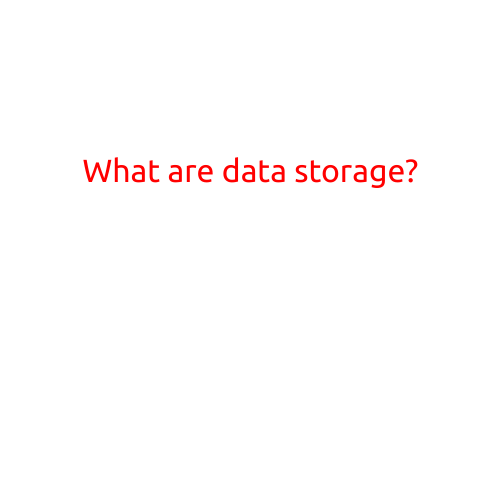
What are Data Storage?
In today’s digital age, data is the backbone of any organization, business, or individual. Data is used to make informed decisions, track progress, and analyze patterns. However, managing and storing data can be a daunting task, especially with the exponential growth of digital data. In this article, we will explore what data storage is, its importance, and different types of data storage solutions.
What is Data Storage?
Data storage refers to the process of storing, retrieving, and managing data in various formats, such as files, documents, images, videos, and audio files. Data storage involves using hardware and software components to store, maintain, and retrieve data, ensuring it is secure, reliable, and accessible when needed.
Importance of Data Storage
Data storage plays a crucial role in today’s digital world. It allows us to:
- Preserve data: Data storage helps to preserve valuable data for future use, ensuring that important information is not lost.
- Improve performance: Data storage enhances performance by allowing systems to access data quickly and efficiently.
- Support business operations: Data storage is essential for business operations, enabling companies to analyze data, make informed decisions, and optimize processes.
- Ensure data security: Data storage provides a secure environment for storing sensitive data, protecting it from unauthorized access, theft, or loss.
- Facilitate backup and recovery: Data storage enables backup and recovery of data in case of system failures, disasters, or data loss.
Types of Data Storage
There are various types of data storage solutions, each with its own strengths and weaknesses. Some common types of data storage include:
- Local Storage: Local storage refers to storing data on a local device, such as a computer’s hard drive, solid-state drive (SSD), or USB drive.
- Cloud Storage: Cloud storage is a centralized storage solution that allows data to be stored, accessed, and shared over the internet. Popular cloud storage options include Google Drive, Dropbox, and Microsoft OneDrive.
- Network Attached Storage (NAS): NAS is a hardware device connected to a network, providing centralized storage and sharing capabilities.
- Object Storage: Object storage is a scale-out storage solution that stores data as objects, often used for large-scale data archives and backup solutions.
- Hybrid Storage: Hybrid storage combines local and cloud storage, allowing users to store and access data locally while also backing up to the cloud.
- Flash Storage: Flash storage uses solid-state drives (SSDs) or other flash-based technologies to store data, offering fast data transfer rates and high reliability.
Conclusion
In conclusion, data storage is a critical component of modern computing, enabling us to store, manage, and retrieve data efficiently. With the ever-growing amount of digital data, it is essential to choose the right data storage solution that meets specific needs, whether it’s local, cloud, NAS, or hybrid storage. By understanding the different types of data storage, organizations and individuals can ensure their data is secure, reliable, and easily accessible when needed.





